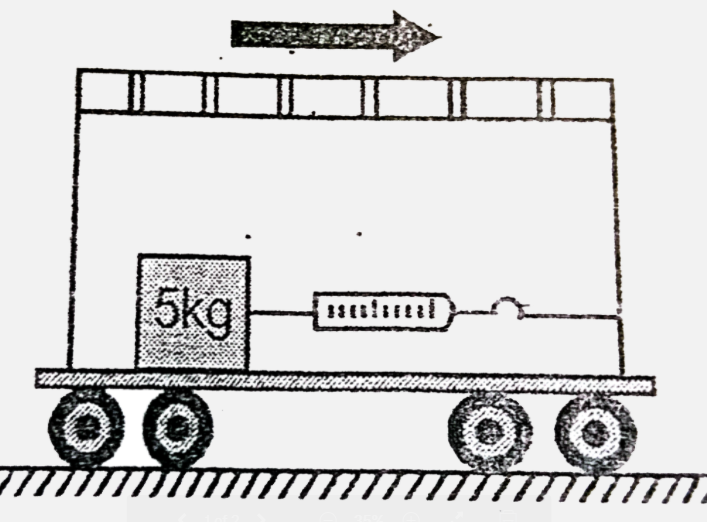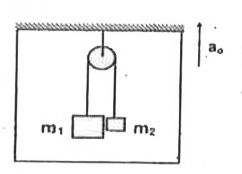The engine of a car produces acceleration in the car. If this car pulls another car of same mass, what will be the acceleration produced
The correct Answer is:C
To solve the problem step by step, we will analyze the forces acting on the cars and apply Newton's second law of motion.
Step 1: Understand the given information
The engine of the car produces an acceleration of 4m/s2 when it is not pulling any other car. Let's denote the mass of the car as M.
Step 2: Calculate the force produced by the engine
Using Newton's second law, the force F exerted by the engine can be calculated as:
F=M⋅a
where a=4m/s2. Therefore, the force is:
F=M⋅4=4M
Step 3: Analyze the situation when the car pulls another car
When the first car pulls another car of the same mass M, the total mass being accelerated is now M+M=2M.
Step 4: Set up the equation for the new acceleration
Using the same force F=4M and applying it to the total mass 2M, we can set up the equation:
F=(2M)⋅a′
where a′ is the new acceleration. Substituting the force we found:
4M=(2M)⋅a′
Step 5: Solve for the new acceleration
To find a′, we can divide both sides of the equation by 2M:
a′=4M2M=2m/s2
Conclusion
The acceleration produced when the first car pulls another car of the same mass is 2m/s2.
---
The engine of the car produces an acceleration of 4m/s2 when it is not pulling any other car. Let's denote the mass of the car as M.
Using Newton's second law, the force F exerted by the engine can be calculated as:
F=M⋅a
where a=4m/s2. Therefore, the force is:
F=M⋅4=4M
When the first car pulls another car of the same mass M, the total mass being accelerated is now M+M=2M.
Using the same force F=4M and applying it to the total mass 2M, we can set up the equation:
F=(2M)⋅a′
where a′ is the new acceleration. Substituting the force we found:
4M=(2M)⋅a′
To find a′, we can divide both sides of the equation by 2M:
a′=4M2M=2m/s2
The acceleration produced when the first car pulls another car of the same mass is 2m/s2.
Similar Questions
The brakes applied to a car produce an acceleration of 6m/s2 in the opposite direction to the motion . If the car takes 2s to stop after the application of brakes , calculate the distance it travels during this time.
View SolutionA racing car has a uniform acceleration of 4m/s2. What distance will it cover in 10s after start ?
View SolutionA simple pendulum is suspended from the ceiling of a car and its period of oscillation is T when the car is at rest. The car starts moving on a horizontal road with a constant acceleration g (equal to the acceleration due to gravity, in magnitude) in the forward direction. To keep the time period same, the length of th pendulum
View SolutionA 2kg block hangs without vibrating at the bottom end of a spring with a force constant of 400N/m. The top end of the spring is attached to the ceiling of an elevator car. The car is rising with an upward acceleration of 5m/s2 when the acceleration suddenly ceases at time t=0 and the car moves upward with constant speed (g=10m/s2)
What is the angular frequencyof the block after the acceleration ceases ?
View SolutionCar A has an acceleration of 2m/s2 due east and car B,4m/s2. due north. What is the acceleration of car B with respect to car A?
View SolutionCar A has an acceleration of 2m/s2 due east and car B,4m/s2. due north. What is the acceleration of car B with respect to car A?
View SolutionA car is moving rectilinearly on a horizontal path with acceleration a0.A person sitting inside the car observes that an insect S is crawling up the screen with an acceleration a.If θ is the inclination of the wind screen with the horizontal, then the acceleration of the insect.
View SolutionA 5 kg mass attached to a spring scale rests on a frictionless , horizontal surface as in figure . The spring scale, attached to the front end of a box car, reads 18 N when the car is in motion .

(a) If the spring reads zero when the car is at rest , determine acceleration of the car while it is in motion .
(b) What will the spring scale read if the car moves with constant velocity ?
(c ) Describe the forces on the mass as observed by someone in the car and by someone at rest outside the car.
View SolutionA pulley fixed to the ceiling of an elevator car carries a thread whose ends are attached to the masses m1andm2. The car starts going up with an acceleration a0. Assuming the masses of the pulley and the thread as well as the friction to be negligible, find:

(a) the acceleration of the load m1 relative to the elevator shaft and relative to the car
(b) the force exerted by the pulley on the ceiling of the car. Given m1>m2.
View SolutionPassage X) A 2kg block hangs without vibrating at the bottom end of a spring with a force constant of 400 N/m. The top end of the spring is attached to the ceiling of an elevator car. The car is rising with an upward acceleration of 5ms2 when the acceleration suddenly ceases at t=0 and the car moves upward with constant speed. (g=10m/s2)
What is the angular frequency of oscillation of the block after the acceleration ceases?
View Solution
